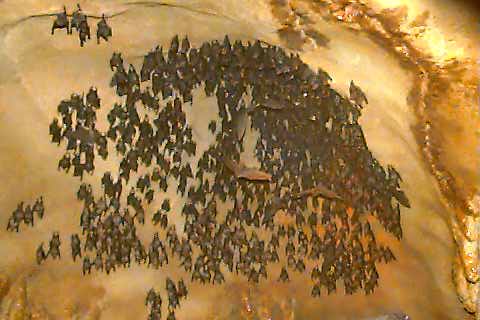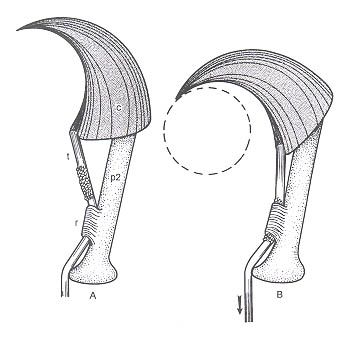
|
Where Do Bats Live? |
Bats spend most of the day sleeping, hidden away in some suitably dark and shadowy corner. They have successfully exploited a variety of shelters, or 'roost-sites', including caves, rock and tree crevices, man-made bat-boxes and probably even your attic!
They are social animals, often roosting together in large colonies. One now-vanished colony of Mexican free-tailed bats (Tadarida brasiliensis mexicana), from the Carlsbad Caverns of New Mexico, was estimated to contain 9 million bats9.

A colony of Cuban Funnel- eared bats
|
Why do bats hang upside down? The arrangement and structure of the tendons in a bats hind foot means that hanging does not involve the contraction of any muscles5. A special locking mechanism allows the claws to grip whether the muscles are relaxed or not, so even dead bats remain hanging. |
 A typical bat hindlimb digit. When the tendon is pulled, the digit locks into a 'hook'. |
| In winter, food becomes very scarce for bats and most temperate-zone species are forced to hibernate16. Thus, bats spend over half their lives subjected to the selective pressures of their roost environment. It is not surprising then, that the conditions and events associated with roosting have played a prominent role in their ecology and evolution . The pressure of predator attack forces microbats to find separate roosts for feeding and sleeping although the larger megabats can afford simply to lie back (upside down!) in their feeding tree14. Thus, megabats fly less at night than microbats - another reason why echolocation is not required in this group. One megabat (Rousettus) is capable of echolocating, but apparently cannot carry food in its mouth while doing so, thus accounting for its feeding and spending the night in the same tree16. |
You may now understand why you perhaps haven't yet had the chance to see one of these peculiar creatures (although you now know where to look!). In fact, almost wherever you are in the world, there is probably a bat lurking nearby. Click here to view their world-wide distribution.







